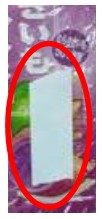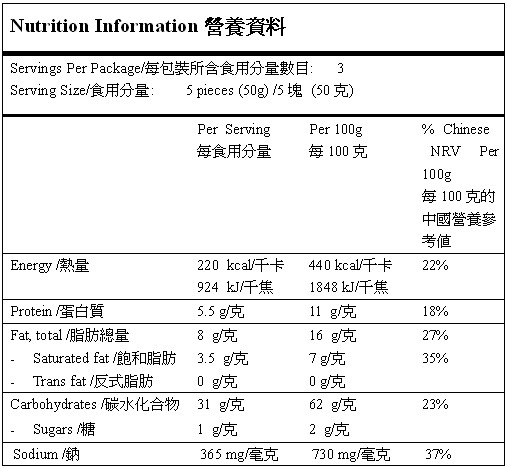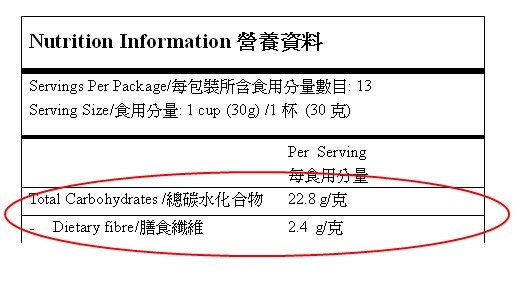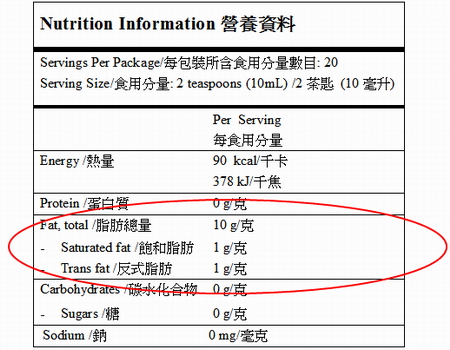Nutrition Labelling - FAQ for general public
- The Amendment Regulation and Nutrition Labelling Scheme
- Nutrition Label
- Nutrition Information
- Nutrition Claims
-
The Amendment Regulation and Nutrition Labelling Scheme
Q1. What is the Food and Drugs (Composition and Labelling) (Amendment: Requirements for Nutrition Labelling and Nutrition Claim) Regulation 2008 ("the Amendment Regulation")?
The Amendment Regulation introduces a Nutrition Labelling Scheme which covers two types of nutrition information on food labels, namely nutrition labelling and nutrition claims. You will find nutrition label in most prepackaged foods from 1 July 2010.
Q2. Why introduce Nutrition Labelling Scheme in Hong Kong ?
It can assist consumers in making informed food choices; encourage food manufacturers to apply sound nutrition principles in the formulation of foods; and regulate misleading or deceptive labels and claims.
Q3. What is the mandatory information in the Nutrition Label?
Nutrition label must include the information on energy and seven nutrients specified for labelling (1+7), namely, protein, carbohydrates, total fat, saturated fatty acids, trans fatty acids, sodium and sugars. Furthermore, the nutrition label must list the amounts of any claimed nutrients. In case where there is a nutrition claim in relation to any type of fat, the amount of cholesterol will also be available.
Q4. Why are these 7 nutrients selected to be shown on the Nutrition Label?
The nutrients chosen are those that consumers, health professionals and scientists consider important to your health. Our scheme (1+7) is also in line with the recommendation of the World Health Organization in 2007.
Q5. Will all prepackaged foods bear nutrition label?
Under the Amendment Regulation, some foods are not required to bear nutrition labels, examples are:
- Prepackaged food in a container with a total surface area of less than 100cm2.
- Fresh, chilled, frozen and dried fruit and vegetable without added ingredients.
- Food with insignificant amount (nearly zero) of energy and nutrients specified for labelling such as spring water.
- Food exempted due to low volume of sales, these products will have specific stickers in circular, square or rectangular shape on the packages to indicate their exemption status.

Q6. Why do I see food packages with some of the wordings blacked out or covered?
Food products with low sales volume could be exempted from nutrition labelling if they do not carry any nutrition claims. Therefore, some traders may black out or cover the wordings on these products' packages in order to make their products exempted. Besides, some of the nutrition claims may not meet certain specific criteria as required by the Amendment Regulation. Therefore, traders might black out or cover the relevant wordings on the food packages.


Illustration: Some of the wordings in food packages are blacked out or covered.
Q7. From time to time, the Centre for Food Safety (CFS) issues Rapid Alert asking the trade to avoid selling "all batches" of an affected product not in compliance with nutrition labelling. Does it refer to all current and future batches?

"All batches" refers to all batches of a product not in compliance with legal requirements of nutrition labelling currently available for sale in the local market at the time when CFS informs trade. It does not cover current or future batches with labels fully complied with legal requirements.
- Nutrition Label
Q8. Why should I read nutrition label?
Nutrition label helps you make informed food choice so as to achieve a balanced diet and stay healthy. You can compare food products and choose according to your own dietary needs. For example, people with diabetes can read the sugar contents of the food products to see whether it fits dietary advice of their doctor or dietitian.
Q9. How does a nutrition label look like?
The nutrition information on the nutrition label is presented in a tabular format similar to the one in Fig.1. You can find the label in a conspicuous place on prepackaged food.

Fig. 1. Nutrition Label of Brand A biscuit (Tabular format)
You will see headings like "Nutrition Label", "Nutrition Information" or "Nutrition Facts". Furthermore, contents of energy and the 7 nutrients specified for labelling are expressed as "per 100g" or "per 100mL", "per serving" or "per package".
You will find nutrition label in English, Chinese (simplified or traditional) or in both languages.
Q10. Will nutrition label be presented in other format?
If the food package has a total surface area of less than 200cm2, the nutrition information can be presented in the linear format just like the one in Fig.2:
Nutrition information 營養資料 Per 100g/ 克 Energy/ 能量 440 kcal/ 千卡 (1848 kJ/ 千焦 ) , Protein/ 蛋白質 11g/ 克, Total fat/ 總脂肪 16g/ 克, Saturated fat/ 飽和脂肪 7g/ 克, Trans fat/ 反式脂肪 0 g/ 克, Carbohydrates/ 碳水化合物 62 g/ 克, Sugars/ 糖 2 g/ 克, Sodium/ 鈉 730mg/ 毫克 Fig.2. Nutrition Label of Brand A biscuit (Linear format)
Q11. What are the differences between "per 100g/ per 100mL", "per serving", and "per package"?
There are three ways to express the energy and nutrient content in the nutrition label, i.e., by per 100g/per 100mL, per serving or per package.
By expressing the content of energy and nutrients in the same reference amount of food, i.e. by per 100g or per 100mL, you can easily compare the contents of different products. For example, if you want to choose a food with lower fat, you can compare the total fat contents of different products. Suppose product A contains 5g of total fat per 100g, whereas product B contains 3g of total fat per 100g, then product B is the choice if you would like to choose lower fat food.
One serving, e.g. three pieces of biscuit, is the amount of food people usually eat in one sitting. Based on the number of servings you eat, you can determine the energy and nutrient intake with reference to their values expressed as per serving. For example if you double the servings of food you eat, you double the energy and nutrient intake from the food.
When a food product is usually consumed as a single serving, the energy and nutrient content may be expressed as per package, e.g. a small container of yogurt or a can of soft drink. In other words, if you consume the whole package of food/drink, you will get the energy and nutrient content as stated in the nutrition label.
Q12. How is the "serving size" on the nutrition label determined?
The "serving size" of a food product is determined by the manufacturer and it varies among different products and different brands. It tells you the amount of food people usually eat in one eating occasion and is expressed in common household measures such as tablespoon, teaspoon, cup, slice or piece followed by metric unit such as gram (g) or milliliter (mL). You will find both the number of servings and the serving size on a food.
For example, the serving size of Brand A biscuit in Fig. 1 is 5 pieces with a total weight of 50g. The whole package of Brand A biscuit contains 3 serves of biscuit. Therefore, the total number of pieces of biscuit (total weight of biscuit) in the whole package of Brand A biscuit is
= 5 pieces x3 (50g x3)
= 15 pieces of biscuit (150g)
- Nutrition Information
Q13. Why do I sometimes find two values next to the energy content in the nutrition label?
The energy value of a food can be expressed as kilocalorie (kcal) or kilojoule (kJ) or both in the nutrition label. 1 kcal is roughly equal to 4.2 kJ.
If you want to compare the energy contents of two different products which are expressed differently, you have to do a simple calculation so that the unit of expression is the same. For example, the energy content of 100 g of Brand A biscuit in Fig. 1 is 1848kJ and that of Brand B biscuit is 400 kcal. If you want to choose one with lower energy, you have to do a simple calculation as below and you will find out that Brand B biscuit is your choice.
The energy content of 100g of Brand A biscuit is 1848 kJ
= 1848 kJ/4.2
= 440 kcal
Q14. Why do some products express the amount of carbohydrates as "Total Carbohydrates" whereas some express as "Carbohydrates" or "Available Carbohydrates"?
Amount of total carbohydrates equals to the sum of the amounts of available carbohydrates and dietary fibre. You will find two different ways to present the amount of carbohydrates in nutrition labels. If the label lists the amount of "Total Carbohydrates", you will also find the amount of "Dietary fibre" similar to the one in Fig.3. The amount of "Available Carbohydrates" of the food product is 20.4g (22.8g – 2.4g) upon calculation.

Fig. 3. (Partial) Nutrition Label of Brand B breakfast cerealIf the amount of "Carbohydrates" is expressed in a nutrition label, it means the amount of "Available Carbohydrates" and the amount of "Dietary fibre" may not be available in the nutrition label.
Q15. Why is the total fat value listed in some Nutrition Labels not equal to the sum of the saturated fat and trans fat?
The amount of total fat listed in the nutrition label includes saturated fat, trans fat, monounsaturated fat and polyunsaturated fat that may be present in food.

Fig.4. Nutrition Label of Brand C oilFor example, in the nutrition label of the oil (Fig. 4), the sum of the trans fat and saturated fat is 2g whereas the amount of total fat is 10g. Therefore, this oil has 8g of fat coming mostly from monounsaturated fat and polyunsaturated fat which are not listed in the label.
Q16. Will nutrients other than the 7 nutrients specified for labelling be available in the nutrition label?
In addition to the 7 specified nutrients, you may also find information on other nutrients (e.g. Vitamin C and Potassium) in the nutrition label. If a nutrition claim is made on a certain nutrient on the food product, e.g. high Calcium, you will find the amount of the claimed nutrient, i.e. amount of Calcium, in the label. If the nutrition claim is in relation to any type of fat, e.g. low in saturated fat, the amount of cholesterol will also be available in the label.
Q17. What is Nutrient Reference Value (NRV)?
Nutrient Reference Value (NRV) is derived for nutrition labelling purposes making reference to the recommended intake levels of various nutrients. It is based on a 2000-kcal diet. The set of Chinese NRVs are more applicable for people in Hong Kong and the Mainland because they are derived for Chinese. For example, the Chinese NRV of saturated fat is 20g, it means that based on a 2000-kcal diet, we should aim at eating not more than 20g of saturated fat per day.
There are food products available which are imported from other overseas countries. Instead of using Chinese NRVs, these products may use different reference values, such as Daily Value (DV) adopted in the US and Canada , or Daily Intake (DI) in Australia . Their reference values are derived based on their own people, not that of Chinese.
Q18. There is a column known as %NRV in some nutrition labels. What is it used for?
The column %NRV expresses the nutrient contents on the basis of percentage of NRV per serving or per 100g/mL of food. For example, Brand C oil in Fig. 4 contains 1g of saturated fat per serving; the %Chinese NRV of saturated fat per serving of Brand C oil will be equal to 5% [(1g/ 20g) x 100%]. The %NRV gives you a quick reference of the nutritional value of a food so that you can tell whether there is a lot or a little of a nutrient using a scale from 0% to 100%. A high %NRV means the food contains a lot of a nutrient whereas a low percentage means it contains just a little.
A general and simple rule is to look for foods that have lower percentages of NRV on nutrients that you need to limit e.g. saturated fat and sodium and higher percentages of NRV on nutrients that are good to your health such as dietary fibre.
Q19. Sometimes I notice that the nutrient values listed on the nutrition labels of the same food product bought at different occasions are slightly different. Why does that happen?
As nutrient composition of foods may be different due to variations in seasons, processing practices and ingredient sources, it may lead to differences in the listed nutrient values among different product batches or products with different expiry dates.
Q20. Sometimes I notice that two nutrition labels appear on the same food package, and the nutrient values listed on these nutrition labels may be slightly different. Why does that happen?
Some prepackaged food may have two nutrition labels on their package, of which one is prepared to comply with the new Nutrition Labelling Scheme in Hong Kong and the other one may have been prepared according to the nutrition labelling requirements of other countries/regions. As the requirements of these countries/regions may be different (e.g. the contents of nutrients that can be stated as "zero" in the nutrition label) from those of Hong Kong, the nutrient values listed on the nutrition labels may be slightly different.
- Nutrition Claim
Q21. Can I believe the nutrition claims on the prepackaged foods?
When the Amendment Regulation comes into operation on 1 July 2010 , the nutrition claims are trustworthy because all food products with nutrient content claim, nutrient comparative claim or nutrient function claim must meet specific criteria. In addition, nutrient function claim e.g. calcium builds stronger bones, to be made on food products must be based on sound scientific evidence so that they are credible for consumers.
Q22. The cereal that I used to have every morning has the description of "high fibre" on the front of the package, is it trustworthy?
When the Amendment Regulation comes into operation on 1 July 2010 , this cereal product must contain at least 6g of dietary fibre per 100g of food before it can claim itself as "high fibre".
Q23. My mother bought a pack of low salt breakfast cereal from the supermarket on the other day. Does it mean the cereal is low in Sodium?
Yes, salt is also known as sodium chloride (NaCl). Sodium may be used as food additives such as sodium nitrate or sodium nitrite whereas some foods including milk naturally contain sodium. If the cereal makes a claim of "low salt" after 1 July 2010 , it must contain not more than 120mg of sodium per 100g of food.
Q24. If Brand A potato chips claims that it contains less fat, does it mean that it is a low fat product?
It depends on the amount of fat as shown on the nutrition label. The phrase "contain less fat" is a nutrient comparative claim. This type of claim compares the energy value or the nutrient contents (in this case, the fat content) in the same or similar types of food, e.g. Brand B potato chips. It does not necessarily mean the food being low in energy or any particular nutrient.
By stating itself as containing less fat, the fat content of Brand A potato chips should be at least 25% less than and at least 3g per 100g of food less than that of Brand B potato chips. You can find the amount of difference next to the claim on the package.
If you want to choose a low fat chips, you have to read the fat content. If Brand A potato chips contains less than 3g total fat per 100g of food, it can claim itself as a "low fat" product.
Q25. Brand C cheese contains 3g of fat per 100g of food and claims itself as low fat. Brand D milk contains only 2g of fat per 100mL of food but it does not claim itself as low fat. Why?
Manufacturers can choose whether or not to put a nutrition claim on their products. Therefore, you may or may not find nutrition claims on the prepackaged foods even though it fulfills the requirement of carrying such claims. For a solid food product to claim as "low fat", it must contain not more than 3g of total fat per 100g of food but for a liquid product to claim as "low fat", it must contain not more than 1.5g of total fat per 100mL of food so Brand D milk cannot claim itself as "low fat".
Q26. People say we should only choose products with nutrition claims such as "low fat", "sugar free" or "no sodium" in order to have a healthy diet. Is it true?
No. Even though nutrition claims can be used as a quick reference for choosing food, you should also read information of other nutrients in the nutrition label for a nutritional overview of food. For example, reduced fat cookies may be high in energy and sugars whereas low sodium potato chips may be high in fat.
Reading nutrition claim together with nutrition label can help you choose a healthy diet, the ingredient list on the label is also useful. Individual ingredients of food are listed by weight from the most to the least. For example, if oat is put in the second place of the ingredient list, right after flour, of a biscuit, you know that this biscuit may contain more dietary fibre when compared with other biscuit putting oat in the last place of the ingredient list.